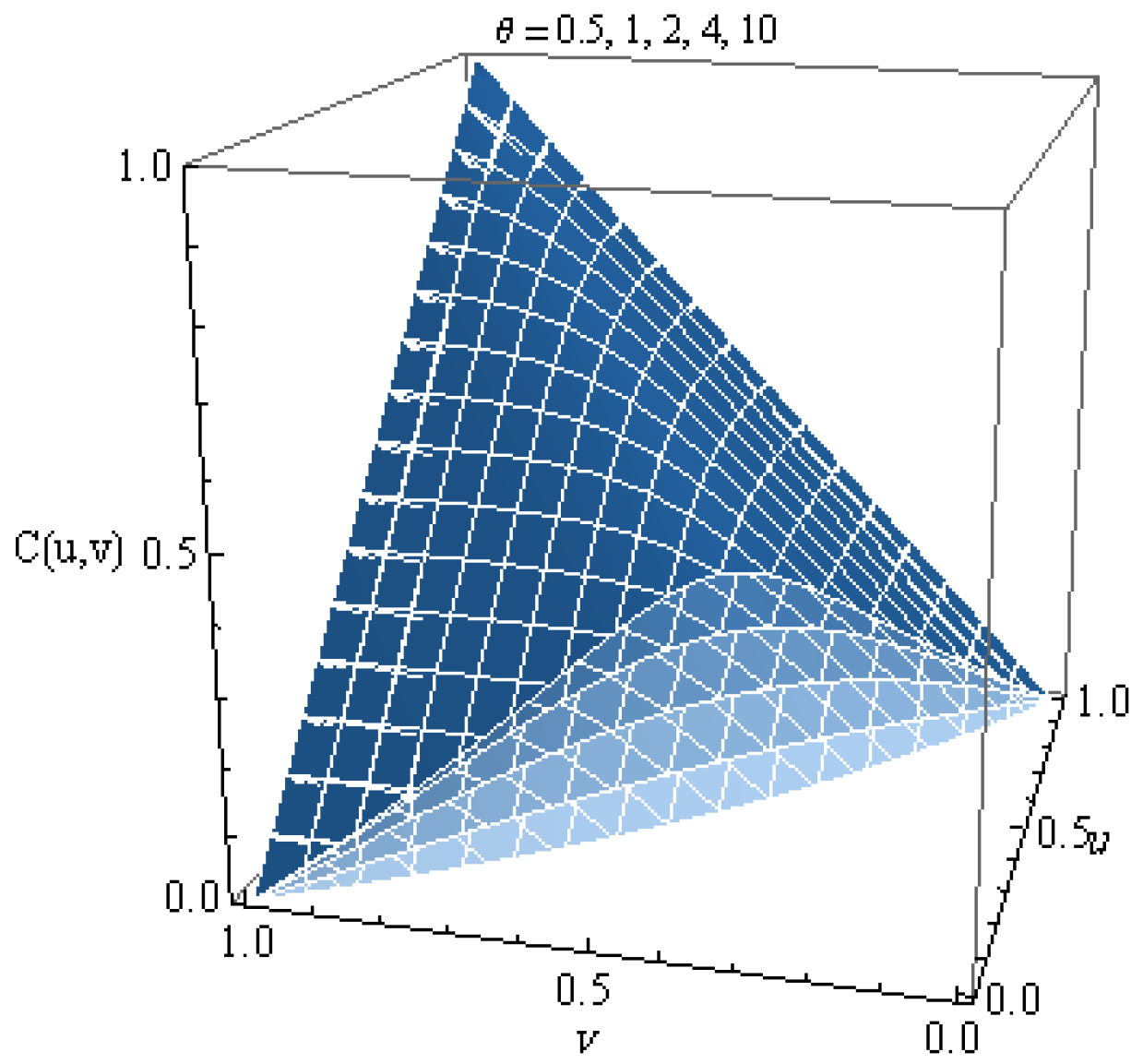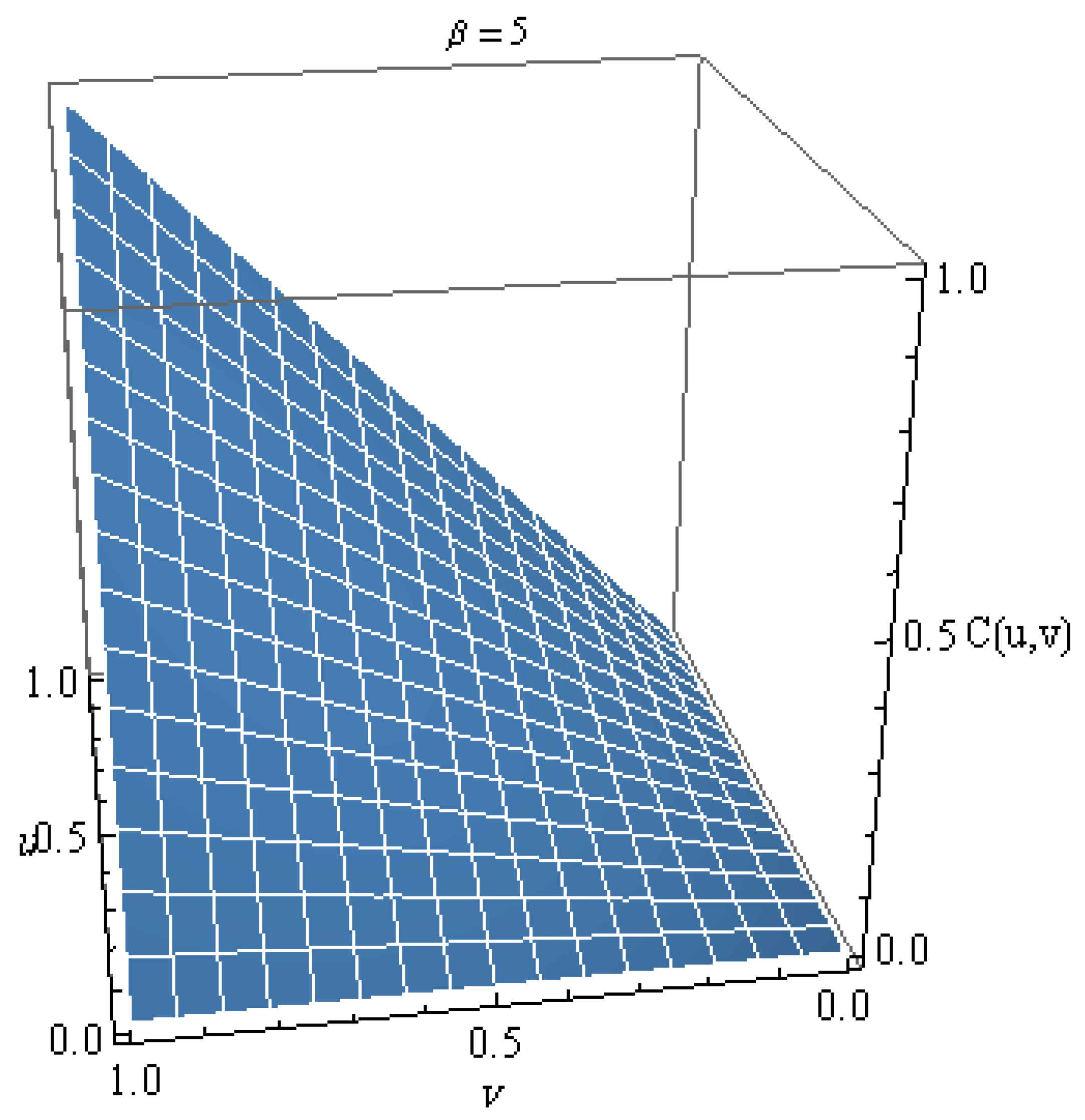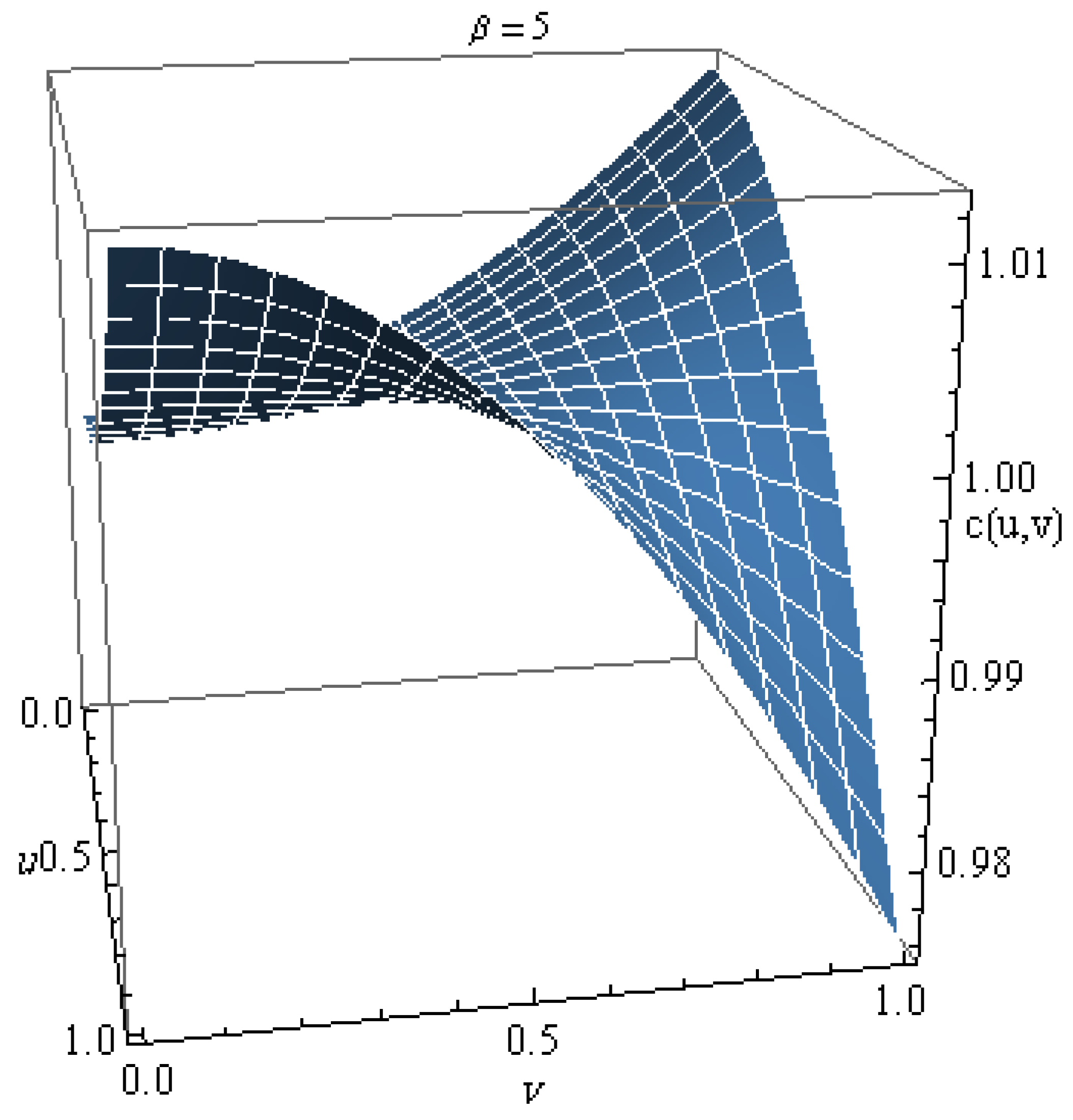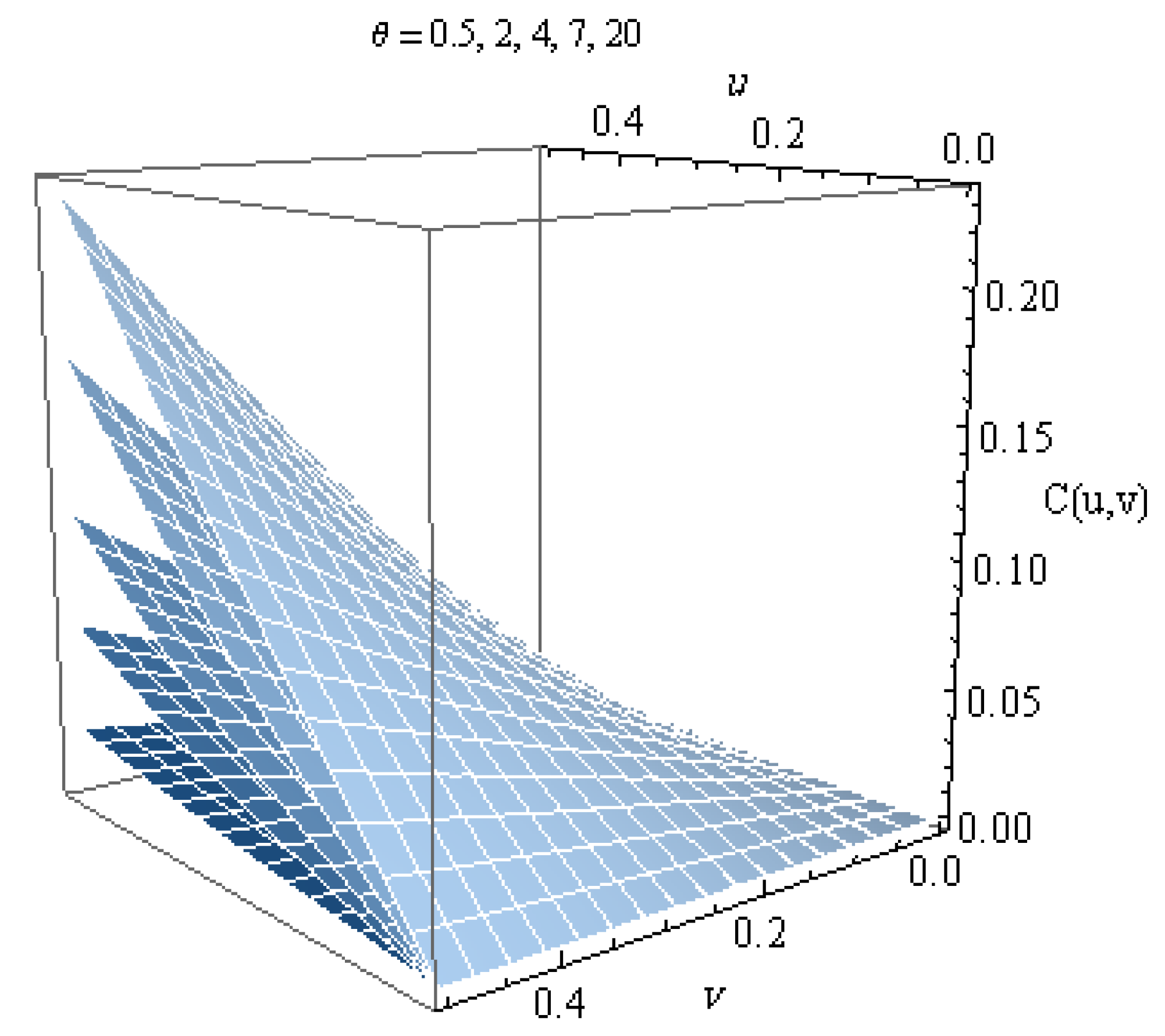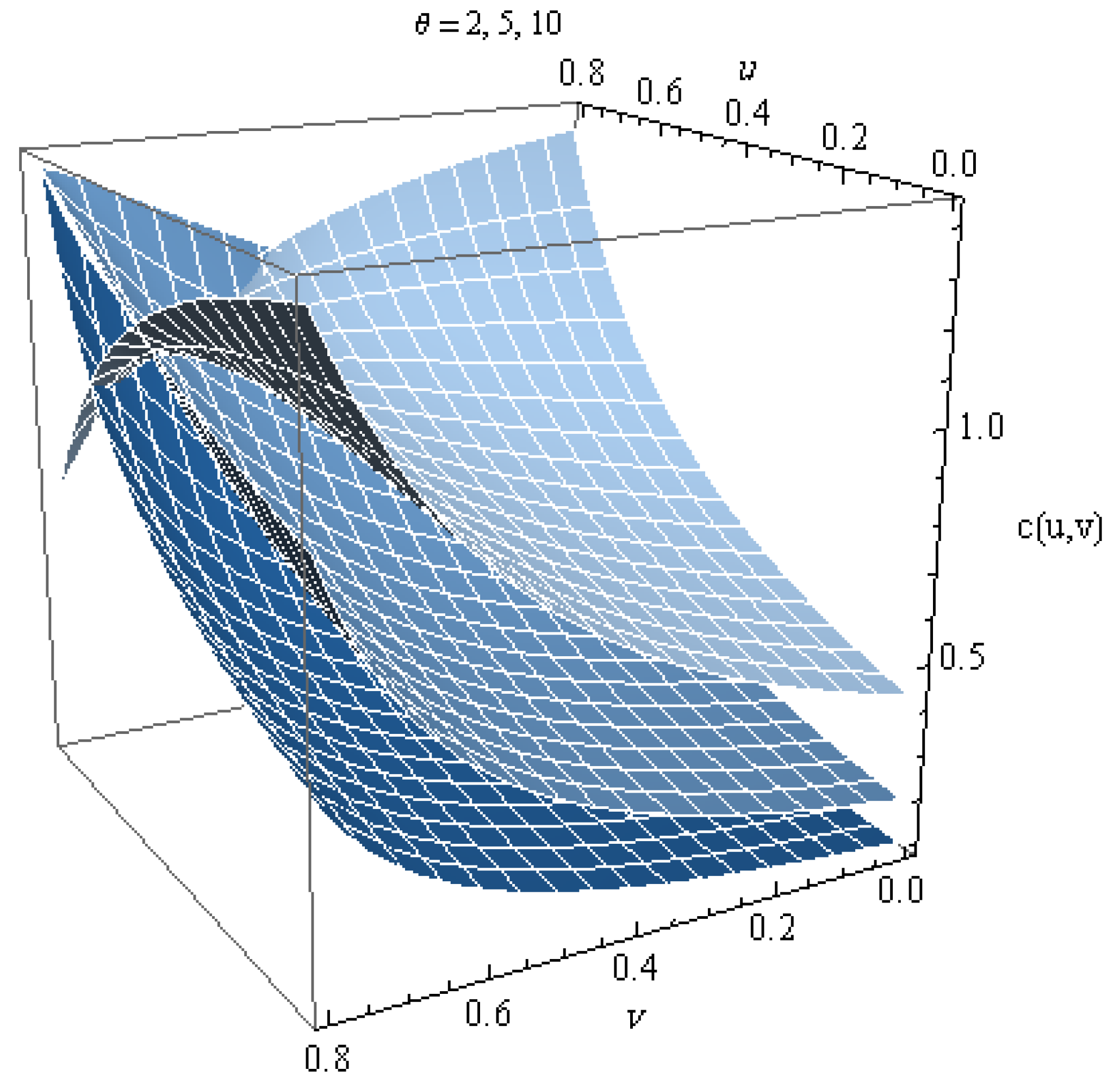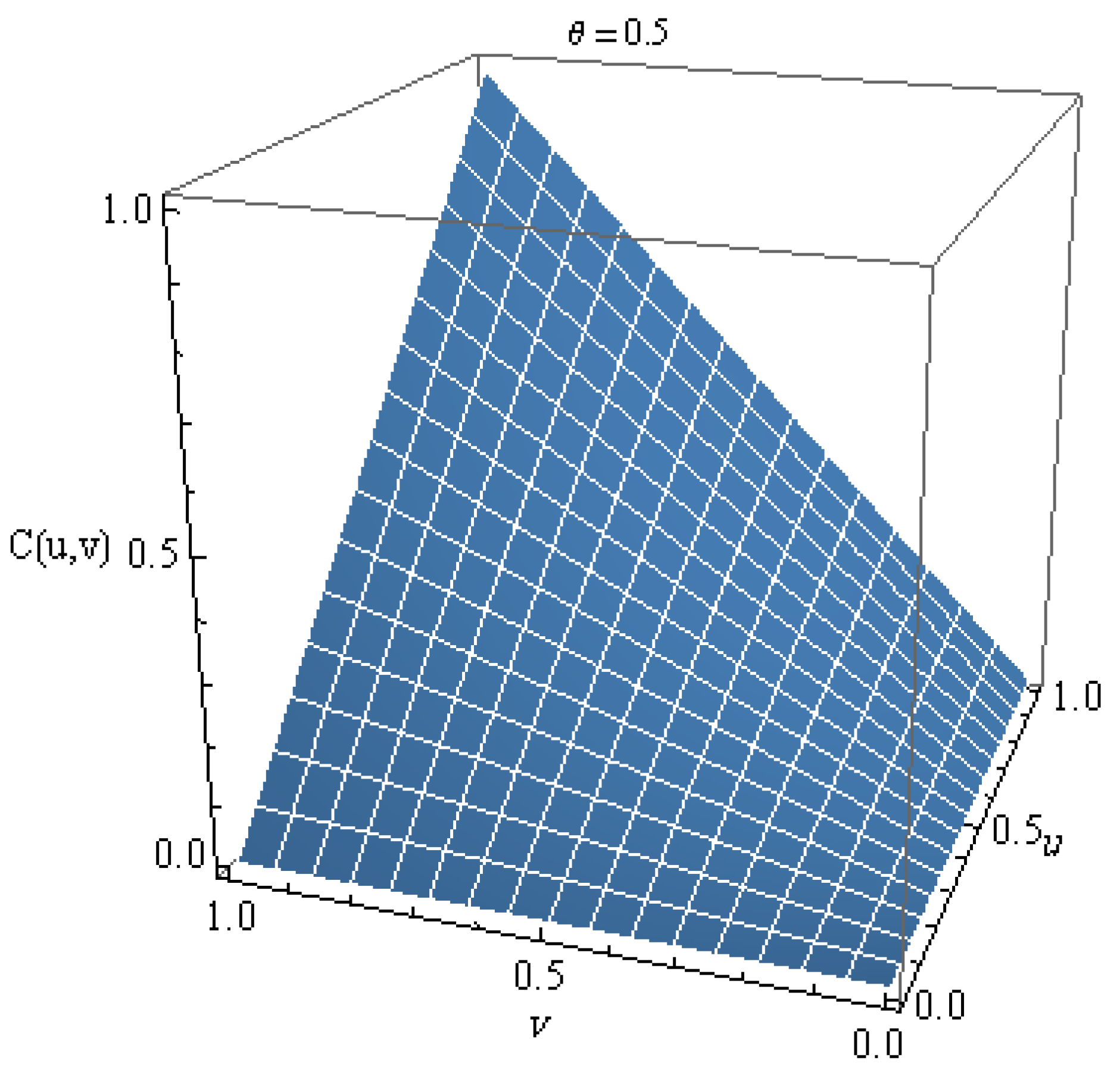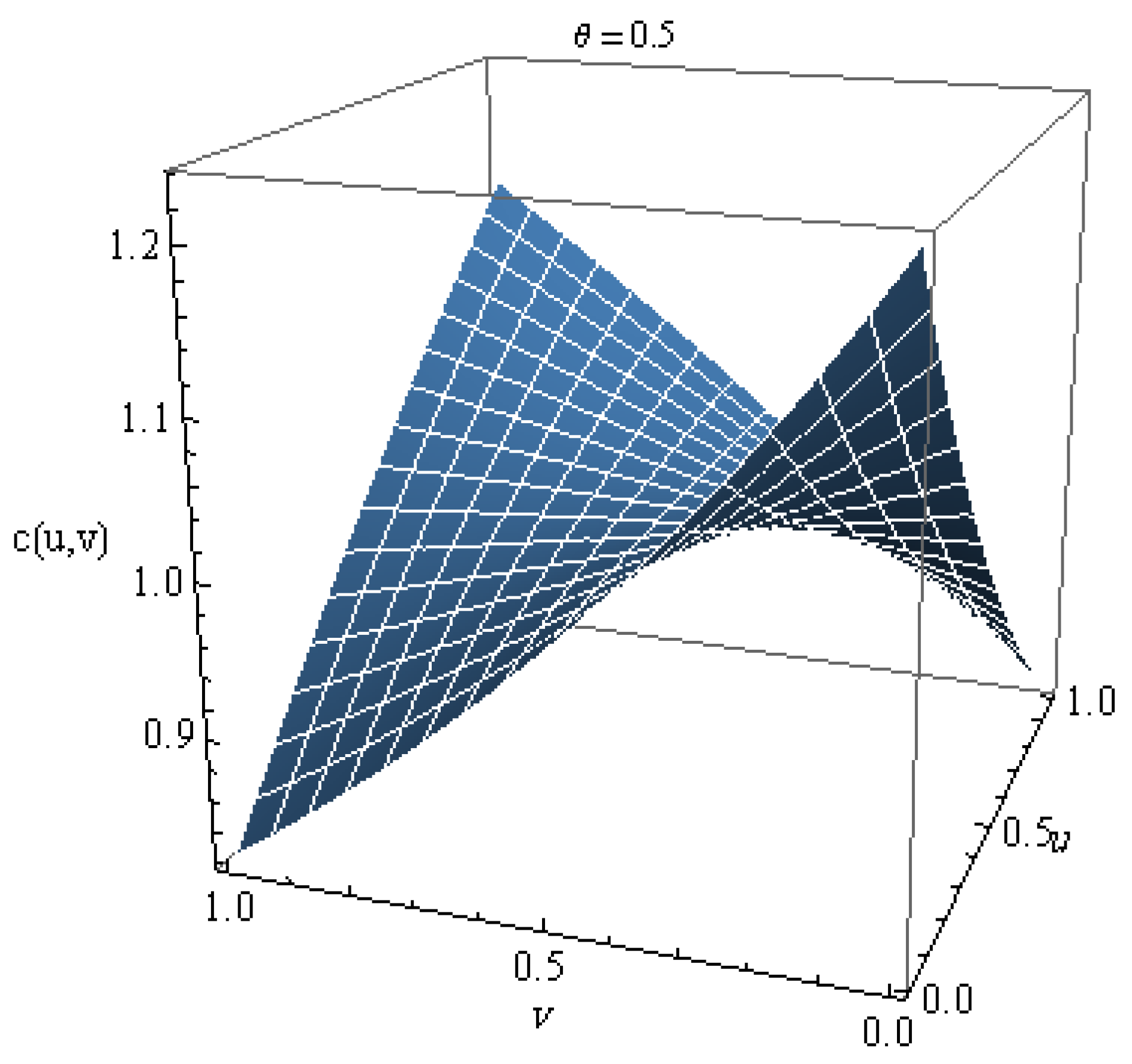1. Introduction
Copulas are multivariate probability distributions with uniform marginal distributions. Hence, they are useful tools to generate multivariate distribution functions along with different dependence structures. The first appearance of copula was in 1959 by sklar [
1]. Recently, there has been increasing attentions paid to copulas. This is due to two important assets of copulas that it is a proper technique to study dependence independently of the marginal distributions, besides, it is a method for constructing multivariate distributions. Accordingly, it is convenient to handle several modeling issues by copulas. Applications from different fields, such as, finance, economy, and survival analysis were studied using copulas. A review of copula applications to multivariate survival analysis can be found in Georges et al. [
2].
Archimedean copulas form an important class of symmetric copulas; due to its simplicity to construct and other useful properties. Genest and MacKay [
3] defined Archimedean copula in the form
, where
is a real-valued function satisfies certain conditions (see
Section 2). The function
is known as additive Archimedean generator. Marshal and Olkin [
4] showed that Archimedean copulas could be easily generated using inverse Laplace transformations. Many famous copulas belong to Archimedean class. For instance, Frank family that introduced by Frank [
5], the Clayton family which appeared first in [
6] and the family of Ali-Mikhail-Haq [
7] are Archimedean copulas.
One of the main interests when studying copulas is to estimate the dependence parameter. An ordinary method of estimation is to maximize the full likelihood function. However, a method of two-steps maximum likelihood could also be used. With this method, the parameters of the marginals are estimated in the first step, then, the dependence parameter is estimated using the copula after replacing the marginals parameters by their estimates. A Bayesian approach is a less common method of copulas estimation. For more details see [
8].
In this paper, we utilize the properties of cumulative distribution functions (cdfs) on to obtain additive and multiplicative Archimedean generators. By observing that the probability generating functions (pgfs) are cdfs on , we give conditions under which these pgf and their inverses can be used as Archimedean generators.
The remainder of this paper proceeds as follows: In
Section 2, we give a short review for both additive and multiplicative Archimedean generators. In
Section 3, some criterions are given to generate copulas from cdfs under several monotonic conditions on their probability density functions (pdfs). Examples of these generators are also presented.
Section 4 address the sufficient conditions on the pgf and its inverse to be multiplicative Archimedean generators. Using pgfs some well-known copulas and new ones are defined.
2. Additive and Multiplicative Archimedean Generators
In this section, definitions for both additive and multiplicative Archimedean generators are presented. Relevant properties of these generators and the interrelation among them are discussed.
Genest and MacKay [
3] gave the following definition for Archimedean generator.
Definition 1. A function which is continuous, strictly decreasing and convex, such that and , is called Archimedean generator.
Definition 2. Let φ be a continuous, strictly decreasing function from I to , such that . The pseudo-inverse of φ is the function given byNote that, if , the pseudo-inverse describes an ordinary inverse function (i.e., and in this case φ is known as a strict Archimedean generator. The definition of Archimedean copula as presented in Nelsen [9] is given by the following theorem. Theorem 1. Let φ be an Archimedean generator, thendefines a class of bivariate copula, the so-called Archimedean copula. In the previous,
is said to be an additive Archimedean generator of the copula
C. Also, Nelson [
9] gave the following definition.
Definition 3. Let be a continuous, strictly increasing and log-concave function, such that . Then, ψ is called a multiplicative Archimedean generator.
Note that, (see [
9], p. 112),
is a multiplicative Archimedean generator if and only if
where
is additive Archimedean generator.
Definition 4. Let ψ be a continuous, strictly increasing function from I to I, such that . The pseudo-inverse of ψ is the function Note that, if , the pseudo-inverse describes an ordinary inverse function (i.e., and in this case is known as a strict multiplicative generator. Consequently, Theorem 1 can be restated as
Theorem 2. Let ψ be a multiplicative Archimedean generator. Then, the functionis a copula. 3. Distribution Functions as Archimedean Generators
Distribution functions and their survival functions are monotone functions and hence certain conditions can be utilized to produce Archimedean generators.
It is very interesting to notice that a distribution function on I is increasing and satisfies and , which are conditions required by multiplicative Archimedean generator. Therefore, under further assumptions one can obtain multiplicative Archimedean generators from such distributions. On the other hand, the survival function is decreasing and satisfied and , hence, it can be used to introduce additive Archimedean generator. In the following we list some results in this direction.
Theorem 3. Let F be a strictly increasing cdf on I with decreasing probability density function f, then the survival function is an additive Archimedean generator (non-strict) and the corresponding copula is Proof. Note that the assumption that F is strictly increasing on I implies is strictly decreasing. Also, the assumption that f is decreasing implies that is convex. Hence, the result follows immediately from Theorem 1. □
Note that
, thus, an equivalent form of (1) in terms of the distribution function is
Example 1. The cdf of the exponential distribution restricted to I is and , which has decreasing pdf as . Therefore, using Theorem 3, we could use as an additive Archimedean generator; which constructs the copula The plot of this copula for different values of
is shown in
Figure 1. From the graph, we can notice that this copula is increasing in
.
Figure 2 shows the density for several values of
, where the density copula is given by
Now, consider the function . Then, is additive Archimedean generator if is decreasing or equivalently is increasing. Hence, we have the following corollary.
Corollary 1. If F is a strictly increasing cdf on I with increasing pdf f, thenis a copula. Now moving to multiplicative Archimedean generating functions, we observe that a strictly increasing cdf on I is a multiplicative Archimedean generator if F is log-concave. Therefore, we have the following theorem.
Theorem 4. If F is a strictly increasing log-concave cdf on I, thenis a copula. Proof. Note that the condition that F is log-concave together with the properties of distribution function make F a multiplicative Archimedean generator. Hence, the result follows. □
Also, if F is a cdf on I then also a cdf. Therefore, we can get a multiplicative Archimedean generator using . This result is stated in the following theorem.
Theorem 5. Let F be a continuous strictly increasing cdf on I with density . Suppose that is increasing on I then the functionis a copula. Proof. As
F is cdf on
I then
is also a cdf on
I. Therefore, from Theorem 4,
is multiplicative Archimedean generator if
is log-concave. But
Thus,
is log concave if and only if
is decreasing or equivalently
is increasing. □
Example 2. Consider the case of Gumbel distribution restricted to I, where . It is easy to check that is increasing. Thus, is multiplicative Archimedean generator, with the corresponding copula Example 3. Consider the density of Beta distribution with . This density satisfies is increasing. Then, the inverse of the cdf is a multiplicative Archimedean generator. Hence, the corresponding multiplicative Archimedean copula isThis is known, in literature, as Joe copula. Example 4. Consider the distribution function discussed in Example 1, as . It can be easily verified that is log concave, also for , is increasing in I. We have . Therefore, the two multiplicative Archimedean copulas corresponding to Theorem 4 and Theorem 5, respectively, areandThe first copula is the well-known Frank copula with positive dependence parameter, while the second one is a new copula. The pdf of is given by Figure 5 and
Figure 6, give plots of the new copula and its density, respectively. It appears from the graph that this copula is decreasing in
θ.
As applications of the cdf criteria to define copulas, we listed in
Table A1,
Table A2 and
Table A3 of the
Appendix A some well-known copulas with their corresponding generators.
4. Probability Generating Functions as Multiplicative Archimedean Generators
Probability generating functions (pgfs) are quite important tools due to their numerous uses. Mainly, the pgf could be used to drive the probability mass function for all possible values of the random variable and their moments. Moreover, a discrete random variable is totally determined by its pgf. For some cases, the use of pgf gives easy way to drive the distribution of the sum of two independent discrete random variables. Here, we demonstrate the use of pgfs as a class of multiplicative Archimedean generators. A sufficient condition for pgf to be a multiplicative Archimedean generator is given in terms of its probability mass function. Some well-known copulas and new ones are derived using pgfs. At first, we will present some preliminary definitions and related properties.
Definition 5. Let X be a discrete random variable with distribution . Then the probability generating function (pgf) G of X is defined bywhere . Note that,
,
and
; i.e.,
G is absolutely monotonic function on
I. Hence, it is strictly increasing convex distribution function in
I with jump
at zero. However, in the case
, we may overcome this obstacle, if it is needed, by considering
or
. It is obvious that
and
are both continuous distribution functions on
I. While
implies that
is continuous, strictly increasing function, with
and
. Then based on Theorem 4, we have the following theorem
Theorem 6. If a pgf G is log-concave then the functionis a copula. Note that, if , then, , but .
Example 5. Consider the pgf for zero-truncated Poisson distribution . Then its inverse is .
Thus, applying Theorem 6, the corresponding copula isThis is known as Frank copula with negative dependence parameter. Before proceeding to the next theorem which discusses the condition on a pgf to be log-concave, there is need to define the following terms.
Definition 6. A non-negative sequence is log-concave if The condition of log-concavity could be rephrased as: For
the ratio
is decreasing whenever
. In general, the pgf is not log-concave. Keilson [
10] discussed the relationship between the log-concavity of probability sequence
and its generating function. Here, we try to give a sufficient condition on
for the log-concavity of the corresponding pgf. We need the following definitions.
Definition 7. A non-negative sequence is ultra-log-concave if An equivalent condition is that, for
the ratio
is decreasing whenever
. Note that, an ultra-log-concavity implies log-concavity. For more discussion, see the review paper [
11].
The following theorem gives a sufficient condition for a pgf to be log-concave in terms of the corresponding probabilities.
Theorem 7. Let G be a pgf of . If is ultra-log-concave, then G is log-concave.
Remark 1. Notice that the ultra-log-concavity condition in Theorem 7 cannot be replaced by log-concavity. Here is a simple illustrative example, let X be a discrete random variable having geometric distribution with parameter p. Note , and hence is log-concave (log-convex) sequence. However, the ultra-log-concavity condition is not applicable. Whereas its pgf is not log-concave (it is log-convex).
The next theorem considers the inverse of pgf as a multiplicative Archimedean generator.
Theorem 8. If , then is a strict multiplicative Archimedean generator. i.e.is a copula. Proof. It is clear that the function is
Continuous on I.
Strictly increasing on I.
and .
Log-concave. Because we have decreasing. Since both and are increasing.
Hence, Theorem 5, gives the result. □
Example 6. Consider the pgf in Example 5. For easy notation, we set , i.e. . Therefore, , and hence, . Thus, applying Theorem 8, one gets the corresponding copula as Now consider the function . Then, W is decreasing and convex. Also, and . Thus, it is a non-strict additive Archimedean generator. Hence, we can get the following result as an immediate consequence of Corollary 1.
Corollary 2. If G is a pgf with , then is an additive Archimedean generator with the corresponding copula Example 7. Consider the pgf of truncated Poisson distribution . Then, , which is the same as survival function of truncated exponential discussed in Example 1.
In Table A4 of the Appendix, we listed some well-known copulas with their corresponding generating pgfs. 5. Conclusions
In this paper, we viewed a cumulative distribution function and probability generating function as Archimedean generators. Sufficient conditions in terms of probability function were discussed. Some new copulas were given.
